- Like
- SHARE
- Digg
- Del
- Tumblr
- VKontakte
- Flattr
- Buffer
- Love This
- Save
- Odnoklassniki
- Meneame
- Blogger
- Amazon
- Yahoo Mail
- Gmail
- AOL
- Newsvine
- HackerNews
- Evernote
- MySpace
- Mail.ru
- Viadeo
- Line
- Comments
- Yummly
- SMS
- Viber
- Telegram
- JOIN
- Skype
- Facebook Messenger
- Kakao
- LiveJournal
- Yammer
- Edgar
- Fintel
- Mix
- Instapaper
- Copy Link
 Top Five Body Transformation Exercises and Why They Work
Top Five Body Transformation Exercises and Why They Work
If you are looking to truly transform your body, there are a few specific things that you need to do to maximize your ability to change, maximize your results, and maintain them. First of all an effective exercise program must be combined with healthful changes to your diet; there’s simply no way around it.
So what makes a great program for change? Though everyone’s goals, needs, and abilities vary, there are things that all result driven programs must have. The first thing a successful fitness program needs is to be a full body program; don’t ever think that you can do a few exercises targeting one or two muscle groups and actually see change. It just doesn’t happen like that.
Compound or Multi-joint exercises which engage multiple muscle groups, especially those that engage the upper and lower body at the same time, are the exercises that will truly transform your body. They can be used to strengthen, build muscular endurance, and be built into a program that focuses on fat burning and cardiovascular fitness.
The body transformation exercises I am going to cover here are basic exercises, nothing fancy, all are bodyweight exercises except for one, and yet these five have the power to completely transform the body like nothing else.
So What Are The Top 5 Body Transformation Exercises?
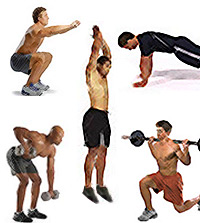 I believe squats, bent over rows, burpees, lunges, and push-ups are the five greatest body transforming exercises because they can be modified to any fitness level and modified to reach any goal. These awesome five can be easily adapted for the most novice or the frailest exerciser or they can challenge a very advanced exerciser or athlete. They focus on compound movements, and activate the largest muscle groups that get the greatest calorie burn.
I believe squats, bent over rows, burpees, lunges, and push-ups are the five greatest body transforming exercises because they can be modified to any fitness level and modified to reach any goal. These awesome five can be easily adapted for the most novice or the frailest exerciser or they can challenge a very advanced exerciser or athlete. They focus on compound movements, and activate the largest muscle groups that get the greatest calorie burn.
There are also countless variations of these awesome five exercises, so you can keep your muscles guessing as you scatter them throughout your workout program for years to come. Muscles can be worked evenly around joints just by changing hand grips, foot positions, and moving in different planes of motion.
Other benefits of these exercises are they can help you develop better balance, core stability, better posture, build and maintain bone density, most of them are functional, everyday movements, and doing them with a full range of motion even helps flexibility.
The best way to take the guessing work out of what your body needs in a well-balanced program, is to hire a personal trainer. A certified personal trainer can assess your fitness level, design a progressive exercise program with variations of these exercises, teach you proper technique to keep you safe, and help you avoid common problems such as overtraining syndrome. The benefits of training with a certified personal trainer don’t stop here either so I highly recommend you seek one out, especially if you are a beginner.
How, What and Why they Work
1.) Squats
Squats can be modified for the most absolute beginner or for the most advanced exerciser, and are a functional, everyday movement. Squats work every muscle in the lower body especially the largest muscles in the body, the butt muscles or gluteus maximus, as well as the front and back of the thighs, the quadriceps and hamstrings. Even though we think of the squat as a lower body exercise, the upper body is activated as you work to keep a neutral spine, with your shoulders positioned back and down, and your chest up. This actually means the full body is engaged to some extent in the squat, and this becomes more so as upper body exercises, dumbbells or a barbell is added as you progress.
Squat technique: Stand with your feet shoulder width apart, toes pointed forward, spine in neutral alignment. Push your hips/glutes back as you bend at the knees to lower into the squat. Pretend you are about to sit back into a chair. Make sure your knees track directly over your feet, and never extend beyond your toes. Keep the top of your chest up, and lower until your thighs are about parallel to the floor. Beginners, keep your arms extended out in front of you and slightly upward to keep balanced. Beginners can also use a chair, lowering just to the point of touching the chair before standing again.
2.) Bent over rows
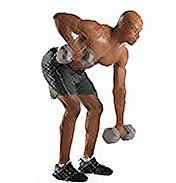 This exercise works the largest muscles in the upper body, the back muscles, known as the latissimus dorsi, the muscles around scapula (rhomboids and trapezius), the back of the shoulder (posterior deltoid), and the biceps (front of the upper arm). The row strengthens us for everyday pulling movements, and is an awesome exercise for working on good posture. Though the movement is taking place in the upper body as the arms are fully flexed and then fully extended again, the muscles around the spine are keeping the low back stabilized as you bend over.
This exercise works the largest muscles in the upper body, the back muscles, known as the latissimus dorsi, the muscles around scapula (rhomboids and trapezius), the back of the shoulder (posterior deltoid), and the biceps (front of the upper arm). The row strengthens us for everyday pulling movements, and is an awesome exercise for working on good posture. Though the movement is taking place in the upper body as the arms are fully flexed and then fully extended again, the muscles around the spine are keeping the low back stabilized as you bend over.
Bent over row technique: Standing with your feet shoulder width apart, push your hips back, keeping a “flat back” or neutral spine, chest out, and shoulders positioned back and down. Keep a soft bend in your knees. The closer your back is to parallel to the floor the better. Begin with palms facing one another and arms fully extended, then bend at the elbows, as you pull the dumbbells toward your ribs. The row can be done with a single arm, with a staggered stance or with one knee placed on a chair or bench for added lower back support.
3.) Burpees
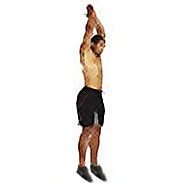 The burpee is a great body weight exercise that engages the full body, really gets the cardiovascular system going, and is highly effective for fat burning. As difficult as burpees are, they can be modified for a beginner or made more difficult with unique variations.
The burpee is a great body weight exercise that engages the full body, really gets the cardiovascular system going, and is highly effective for fat burning. As difficult as burpees are, they can be modified for a beginner or made more difficult with unique variations.
Burpees technique: Begin in a plank position with arms fully extended, palms at shoulder level just a bit wider than shoulder width apart. Hold the abdominals in tight and make sure to keep a neutral spine. Hop your feet forward toward your hands, and then jump up. Lower the body again first into a squat, place hands slightly in front of you, then thrust feet back so you are back in the plank position. For added intensity do a full push up rather than holding a plank. For a beginner, or someone who is not able to tolerate the quick up and down movements of the standard burpee, a very simple, yet creatively modified version could be done against a counter, a chair, or even a wall. Once you’ve progressed to the floor, you could step the feet back and forward rather than thrust them quickly, to take out some intensity. The jump can be taken out until you progress up to it, or if you want to decrease joint impact.
4.) Lunges
 The lunge exercise works the muscles in the lower body, and emphasize the work to the gluteus maximus, quadriceps, and hamstrings. They should be done sideways or laterally as well to strengthen the muscles evenly on the outside of the hip (gluteus minimus and medius) and the inner thighs (adductors). The basic forward and backward lunges help develop balance and core stability. Your upper body is completely engaged as you keep your spine up tall, shoulders positioned back and down, and chest up while working to maintain balance.
The lunge exercise works the muscles in the lower body, and emphasize the work to the gluteus maximus, quadriceps, and hamstrings. They should be done sideways or laterally as well to strengthen the muscles evenly on the outside of the hip (gluteus minimus and medius) and the inner thighs (adductors). The basic forward and backward lunges help develop balance and core stability. Your upper body is completely engaged as you keep your spine up tall, shoulders positioned back and down, and chest up while working to maintain balance.
Forward lunge technique: Begin with your feet close together, body up tall with spine in neutral alignment. Take a big enough step forward so that the knee of your front leg is directly over the ankle and never extends beyond the toes. The heel of the foot of your trailing leg should be up off the floor. Keep your spine up tall; drop your back knee straight down so that your front thigh is about parallel to the floor. Push off with the heel of your front foot to propel yourself back to the starting position. Beginners can place one hand on the back of a chair for added support. Dumbbells and upper body exercises can be added as you progress.
5.) Push-ups
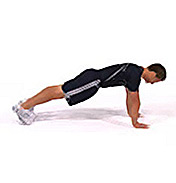 This is a great exercise that not only strengthens the chest (pectorals), the front of the shoulders (anterior deltoids), and the back of the upper arms (triceps), it will also help you develop core strength and stability as the hips, abdominals, and deep muscles around the spine are held tightly in an isometric hold to stabilize the spine. Definitely one of the greatest full body exercises, it can be first learned as a plank, even in its most simple variation on the wall, progressing to the floor in a modified, then full version.
This is a great exercise that not only strengthens the chest (pectorals), the front of the shoulders (anterior deltoids), and the back of the upper arms (triceps), it will also help you develop core strength and stability as the hips, abdominals, and deep muscles around the spine are held tightly in an isometric hold to stabilize the spine. Definitely one of the greatest full body exercises, it can be first learned as a plank, even in its most simple variation on the wall, progressing to the floor in a modified, then full version.
Push-up technique: Begin in a prone position, belly toward mat with arms extended and palms at shoulder level, just a bit wider than shoulder width apart; have your legs extended out straight, feet close to one another, up on the balls of your feet. Hold your core tight and keep a neutral spine. Do not droop your head, your belly, or raise your glutes; keep straight from head to heel. Next, bend at the elbows, dropping your chest until you are 12 to 6 inches from the floor. Push your body back up until arms are fully extended.
The Awesome Five!
Yes, the entire body is engaged to some extent in each of these exercises – which is the reason I’m calling them the Awesome Five, and the reason why they are truly body transforming exercises. Because these exercises target the upper and lower body, front and back of the body, are compound exercises, and can be modified to move the body in all directions, they can be done as their own program, or you can put any one of them into your existing program.
You can also reach any of your goals by using some variation of these body transformation exercises. If you want a program that focuses more on fat burning, put some variation of burpees or another cardio exercise in between the strength training exercises. If you want to build larger muscles, use moderate weights and have rest periods between sets of strength training exercises. Depending on the extra weights you use, the rest periods, whether you add extra cardio, and the intensity you work at, the possibilities are truly endless.
It’s always best to hire a certified personal trainer to design a program with the appropriate variations of these exercises depending on your fitness level and goals.
Final Thoughts
Combine healthier food choices with an exercise program which includes these awesome five exercises and you have the tools for total transformation of your body, inside and out. Fancy gym equipment and complicated moves are not needed to change your body; proper form, the right exercises for you and your willingness to work hard are all that’s needed.
These five basic exercises and simple, creative variations of them are more than enough to help you reach your goals. Squats, bent over rows, burpees, lunges, and push-ups: add a variation of these awesome five exercises to get and keep results.
References
Delavier, F. (2006). Strength Training Anatomy, Second Edition. Champaign, IL: Human Kinetics.
Earle, E.W., Baechle, T.R. (2004). NSCA’s Essentials of Personal Training. Champaign, IL: Human Kinetics.
See Also:
- Best Plyometric Training Exercises
- Functional Training Exercises for Beginners
- Low Impact High Intensity Interval Training
About Rochelle Ramirez
Author's Website Rochelle Ramirez is an enthusiastic personal trainer and wellness speaker. She holds personal trainer certifications from the NSCA and ACE, is a certified group instructor through AFAA, a certified Aqua Fitness instructor through APAI, and is a Battling Ropes Level 1 Coach. Rochelle’s specialty is in designing highly effective, low impact workouts that focus on the needs of Older Adults and Senior Population. She also holds a BA in Liberal Studies with a minor in English from Cal Poly Pomona, and graduated from CNI College with a certificate in Personal Training / Exercise Science. Rochelle’s philosophy is simple; she believes that the human body is the greatest work of art, and that it’s our responsibility to move it correctly and feed it healthfully for a lifetime.

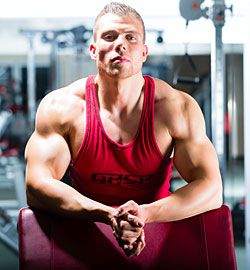 Top Five Body Transformation Exercises and Why They Work
Top Five Body Transformation Exercises and Why They Work
Bent over rows are inferior to pullups. You should have left out bent over rows and included pullups instead.